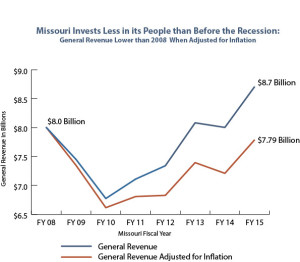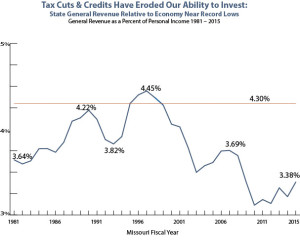As the Missouri legislature dives into the 2016 legislative session, legislators have a choice. They can get bogged down in politics, or they can begin to address real problems facing Missouri families.
Over the next two weeks, MBP will highlight where we’ve been as a state over the past two decades, and how we can start down the path to a better tomorrow: a bright future for our children, security for our seniors, and an economy where working hard means you can get ahead.
Today we’ll look generally at how Missouri’s investments in its greatest resource – its people – has deteriorated.
On Wednesday, we’ll examine how cuts to all levels of education have made it harder for Missourians to get ahead.
And next week we’ll take a look at how the health of Missourians has been compromised over the last decade or more, all undercutting our state’s ability to compete, and Missourians’ quality of life.
Background: Investments in Missourians Have Suffered
Our state’s ability to invest in the future has been compromised by both the recent economic recession and decades of policy decisions that prioritized tax cuts over ensuring we have the resources need to educate our children and keep our communities healthy.
- When adjusted for inflation, our state now has fewer resources to invest in the well-being of our citizens than we did in 2008.
- Between 1993 and 2013, 20 different special interest tax cuts and expanded tax credits have cost a combined $1 billion per year.
- So while state revenue is recovering from the Great recession, our ability to contribute to our future is near record lows relative to the size of the economy.

- When voters passed the Hancock amendment in 1980, they expected that while their taxes would be limited, the state would continue critical investments in in the underlying foundation of the economy, like education, health care, and infrastructure. But now Missouri general revenue is about $4 billion below the level outlined in the Hancock amendment. And our ability to build a better future for our children has been devastated.
We can do better. Between now and the State of the State on January 20th, we will outline how these decreased investments have impacted education and health in Missouri and show how some common sense solutions will not only help us meet the educational and health needs of Missourians, but will make us more competitive in the future.

